ASUS P5E3 Premium: One to Rule them All…
by Kris Boughton on February 20, 2008 12:15 AM EST- Posted in
- Motherboards
Board Layout and Features
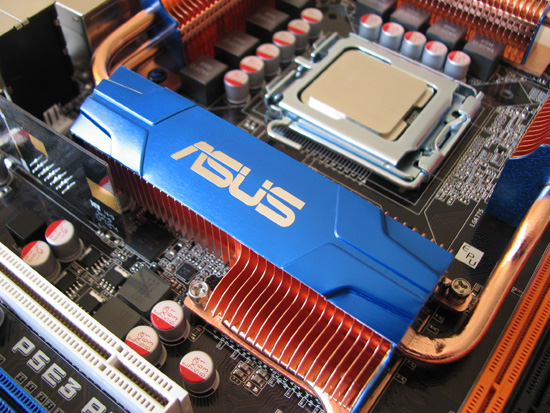
ASUS has managed to create an eye-catching board, from the all-copper cooling solution and the subtle blue tint on the LGA775 socket, to the tasteful expansion slot colors and the black PCB. If appearance is a major factor in your hardware purchases, the P5E3 Premium could be love at first sight; we were certainly impressed by the aesthetic balance. A quick and easy way to distinguish the Premium from the Deluxe (Intel X38 based) variants of the P5E3 series is the deep cobalt blue anodizing on the heatpipe covers and side supports. Although we try not to place too much weight on how a board looks, it's nice that users won't have to compromise with an ugly-but-fast board.
The single-piece heatpipe assembly is entirely capable of controlling Northbridge temperatures, even when pushing the board to its limits. ASUS has improved upon the already impressive mounting system by including screws that do not limit their travel to the point where the heat sink may feel "loose." The portions of the assembly covering the Northbridge and the Southbridge include back plates, a feature that allowed us the ability to ensure optimum heat transfer after we replaced the thermal interface material (TIM) with OCZ Freeze and gave the screws a few extra full turns. The heatsinks located above the power MOSFETs are still attached using plastic pushpins and flimsy metal springs - we would also like to see some black plates for these as hard mounting them would bow the board to the point that some of the components would no longer make proper contact with the heatsinks.
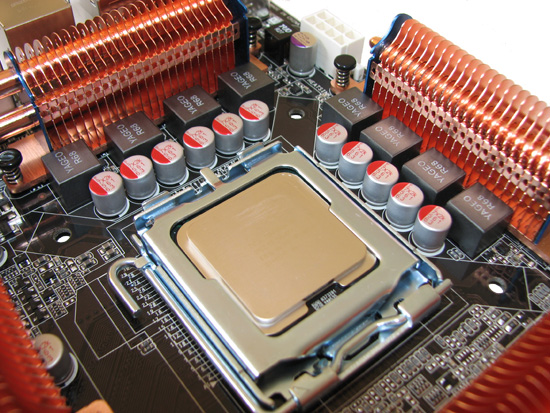
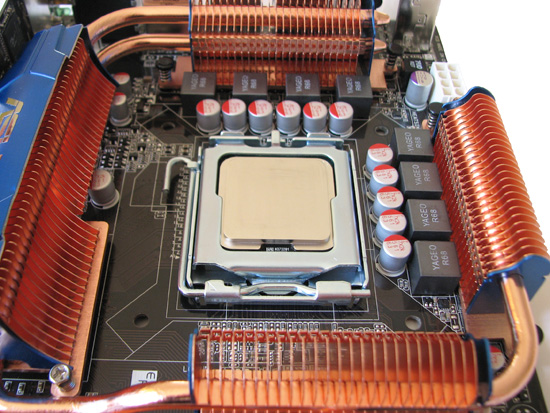

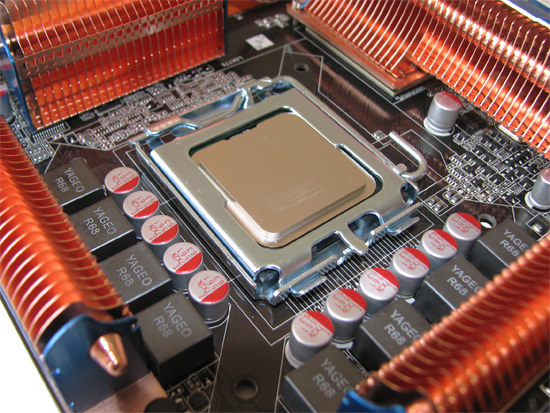
ASUS' power delivery system is among the best in the business at this time. An ADP3228 PWM controller commands an 8-phase solution, made up of low-DCR, solid ferrite-core Yageo inductors, and ultra-low ESR Nichicon capacitors. However, we feel that the two 270uF input power filter capacitors used to remove any ripple in the 12V line coming from the PSU were somewhat undersized for the task. We would like to see capacitors used here which provide at least 2000uF of total supply capacitance. The P5E3 Premium also includes an EPU (Energy Processing Unit), which functions to increase the VRM efficiency 7% by reducing the number of operating phases from eight down to four during periods of light system loading. However, given the incredibly low idle power consumption of Intel 45nm CPUs and G0-step 65nm CPUs, 7% usually works out to rather small savings. Don't expect to see a significant difference in power requirements from this feature alone. Regardless, every bit helps, so we applaud ASUS for their efforts.

Here we can see the familiar trademark of DDR3 memory expansion slots - no on-board termination resistors. As an aside, one of the many improvements included in the change from DDR2 to DDR3 was the movement of motherboard-level termination resistors to the DIMM modules themselves. A closer look at any DDR3 module should reveal the presence of multiple arrays of 4-pack resistor SMDs used to terminate the command and data signal lines as close to the memory dies as possible. Not only does this improve overall signal integrity, allowing for stable operation at much higher memory speeds, but the memory power delivery solution can benefit as well. Fewer discrete components located near the DDR3 expansion slots means routing of power delivery (VDDQ) and ground planes can be made much cleaner - a fact ASUS takes advantage of by slightly widening the channel spacing to allow for the placement of extra bulk capacitance.

The changes don't end there though. ASUS' new P5E3 Premium is the world's first motherboard to employ a 3-phase memory power solution, shown in the above picture. Out of all the innovations introduced on this motherboard, this was by far one of our favorites. Strong, stable power delivery and solid reference voltages are vital in the success of any memory overclock and this board does not pretend otherwise. Worth noting, we measured the P5E3 Premium as overvolting the memory by about 0.05V with nearly no noticeable droop.
Also seen here are the "OV_CPU" and "OV_NB" jumpers, which select whether or not to allow the use of the higher, secondary voltage ranges available via the BIOS. Most if not all users should find they have no reason to change their positions, as they unlock what we would consider to be ridiculously high voltages. The Winbond SuperIO chip sits at the corner of the board.
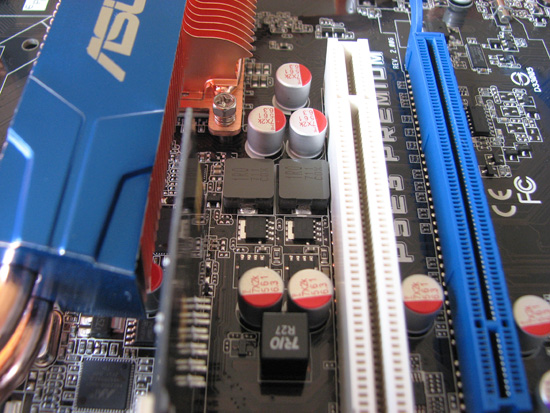
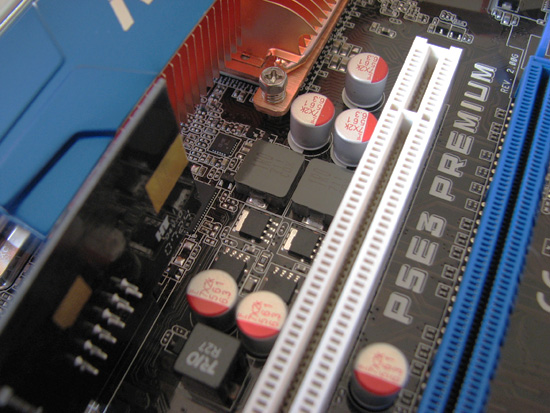
Not wanting to be left out, the Northbridge (MCH) is powered by a robust 2-phase system, something we have already grown to expect when it comes to the high-end X48 motherboards. ASUS' implementation is particularly interesting in that their solution utilizes the same exact MOSFETs used in both the CPU and memory power delivery circuits. Again, a clean, stable power supply is vitally important in any overclocking scenario. Our measurements showed the board overvolting the MCH by about 0.05V with about 0.01V of droop under load.










32 Comments
View All Comments
ArthurCanada - Thursday, October 2, 2008 - link
Indeed folks. This is the most advanced and powerful board I have ever installed in a computer. I am running Vista Ultimate 64 bit and pushing my E8500 to 4 Ghz per core, much like in the testing. I can't begin to tell you how fast this motherboard with the E8500 is.For overclockers ... this is the board they have been waiting for. Period!
Arthur
Canada
drnick79 - Tuesday, April 1, 2008 - link
HelloI purchased this board with 2x1GB sticks of OCZ DDR3 1800 memory to use with my e8400 CPU (which I can get stable to at least 4050mhz on other mobos). What RAM did you use for this testing? I can't even come close to running stable at the settings you have listed, nor can I score any higher than about 11,500MB/sec read and 46ns with everest benchmark, and the settings I used to achieve those values are very unstable. And 1N memory settings??? This board won't even post if I set the memory to 1N running the memory over 1333mhz.
Just wondering if you could share the RAM brand you used along with your motherboard and RAM voltage settings to achieve such a feat.
Thanks,
Nick
HotBBQ - Monday, February 25, 2008 - link
"With an estimated retail price of around $299, there is a lot of value in the purchase of the P5E3 Premium for those looking at a high-end motherboard to use in the coming years."Where did the $299 come from? The X38 version of this board comes it at $340.
fabz - Saturday, February 23, 2008 - link
HiGreat review! I have been reading alot here att anandtech and generally all over the web preparing my first ever pc-build. Intel seem to be the way to go.
But,
have a look at the link posted below:
http://www.hardware.info/nl-NL/productdb/bGRkapiTm...">http://www.hardware.info/nl-NL/productdb/bGRkapiTm...
The DDR3 power circuit is different to the one here att anandtech. Still it claims to be the same board. At least so it seems to me. A couple of other sites have the same pics with different power circuits.
Are there different versions of the P5E3 PREMIUM/WIFI-AP@N in circulation? If so, how do i tell them apart before buying?
/Fabricio@cold, dark winter-sweden.
Aivas47a - Friday, February 22, 2008 - link
The one request I've had for Asus lately is to provide greater flexibility for fine-tuning of GTL reference voltages, as this is key especially for quad core overclocking. I'm delighted that Asus has apparently listened and responded.KainAT - Thursday, February 21, 2008 - link
Hi Kris. Very nice view for the mobo.As you have been practicing and analizing a lot on how doe sthe GTL reference voltage works, which settings for CPU and NB on GTL did you used for 550 FSB?
Also, which voltage should you consider to be the max for 24/7 situations? Around 1.4v?
If we had to do an analogy, between conroe and Wolfdale, when Conroe max voltage for 24/7 was around 1.5-1.6volts, on that time, being 1.3v the stock aprox. Now, with Wolfdale, 1.125v is about the common VID, so, which would be the voltage limit for 24/7?
Thanks on advise.
Kain
PolymerTim - Wednesday, February 20, 2008 - link
Maybe I missed the system specs. I can see the proc in the CPU-z shots, but I'm really curious what RAM you used for this test. Even though I know the MB is critical for getting this kind of performance out of the RAM, not mentioning which one you use seems to imply that you can get these results with any decent DDR3 RAM. Is that so?Thanks very much for the article. I very much appreciate reading a well crafted piece like this with lots of insight.
Xvys - Wednesday, February 20, 2008 - link
While this looks like a nice m/b, I am not as astounded by the memory performance as the writer of the article. On my Asus P5K-D, I acheived 44.5ns latency and memory read of 11,250...with only 2/3rds of the memory bus of the tested board. I am sure I could improve on that figure a fair bit if I was optimized the speed and timings for that purpose.AllanLim - Wednesday, February 20, 2008 - link
Yes, the X48 looks impressive as it should, but let's not forget this is NOT a retail sample. I just think it's misleading and premature to claim "To rule them all" when we haven't even looked at other X48 mobos.kjboughton - Wednesday, February 20, 2008 - link
Hi, to date we have reviewed the following Intel X48 boards: Gigabyte GA-X48T-DQ6, ASUS R.O.G. Rampage Formula, MSI X48 Platinum and ASUS P5E3 Premium (with the possibility of more to come). Thank you.